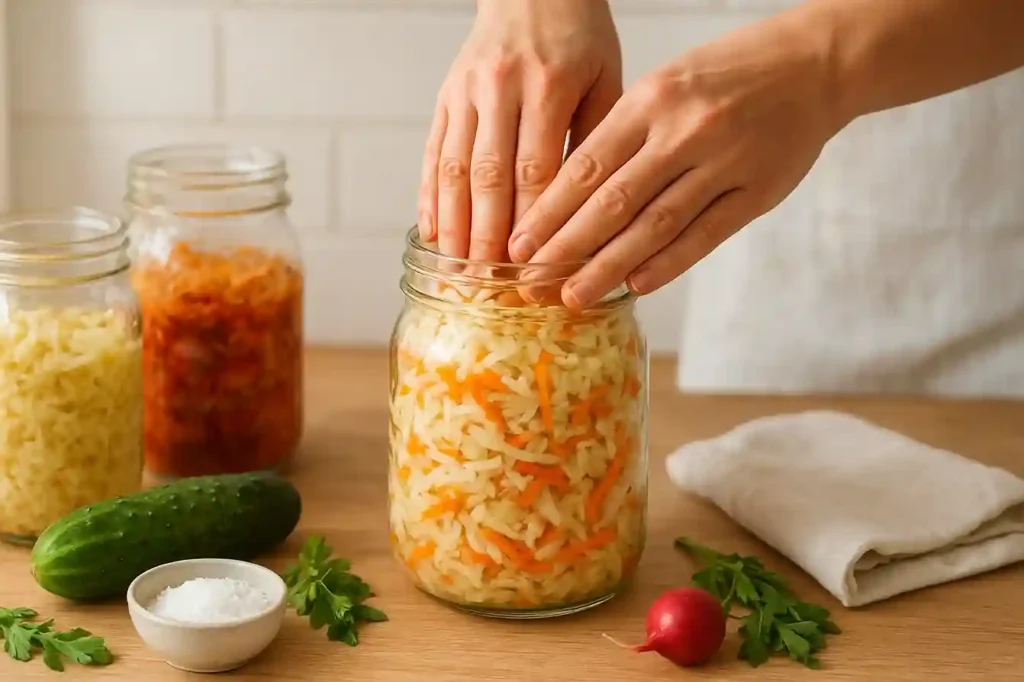Fermented vegetables are foods transformed by natural bacteria during the process of fermentation. This simple method preserves and enhances flavor. Fermentation produces probiotics that support gut health. These good bacteria improve digestion and strengthen the immune system naturally. Eating fermented vegetables regularly can boost overall wellness without complicated steps.
Making homemade fermented vegetables is easier than most people imagine. With just salt, water, and fresh produce, you can begin. Easy fermentation methods let you prepare DIY sauerkraut or even try kimchi at home. The process requires little equipment and can be mastered by beginners.
What Are Fermented Vegetables?
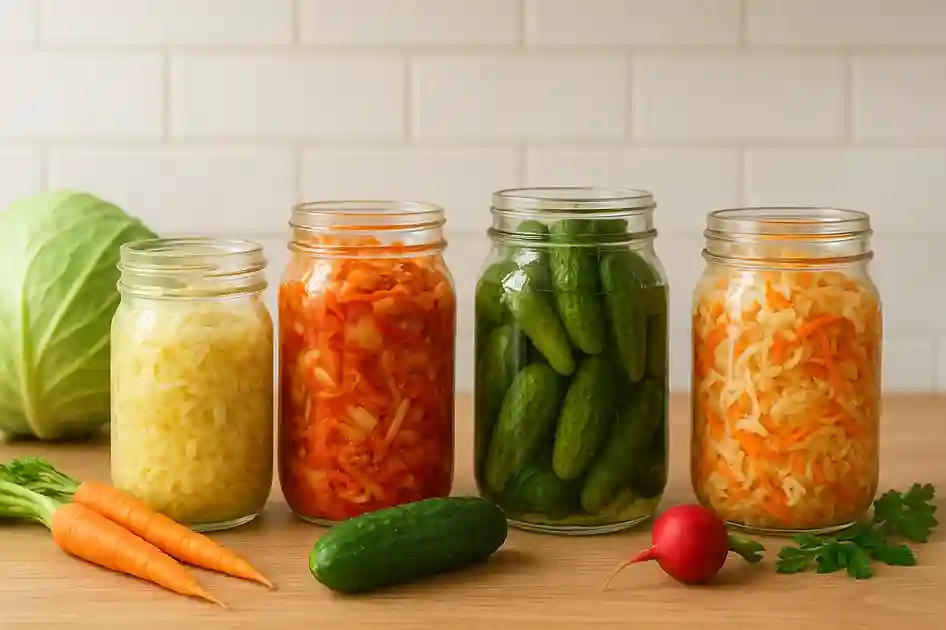
Fermented vegetables are fresh produce preserved through a natural process called fermentation. In this method, beneficial bacteria convert sugars into acids. This creates a tangy taste and extends shelf life. Classic examples include DIY sauerkraut, kimchi at home, and pickled vegetables. These foods not only stay fresh longer but also gain unique flavors. Every culture has its version of fermented vegetables, making them a global tradition.
The key benefits are simple yet powerful. Fermentation enhances taste, improves preservation, and supports health through probiotics. Eating homemade fermented vegetables offers both nutrition and enjoyment.
Why Ferment Vegetables at Home?
Control Ingredients
Homemade fermented vegetables give you full control over what goes into your food. Unlike store-bought versions, they contain no hidden preservatives or chemical additives. You decide which vegetables to use, whether crunchy cabbage, crisp cucumbers, or seasonal produce from your garden. The process is simple and requires only three essentials: fresh vegetables, clean water, and natural salt. This minimal ingredient list ensures purity and preserves nutrients that might be lost in processed foods. By preparing fermented vegetables at home, you protect your health while enjoying clean, natural flavors. Every jar reflects your choices, making it safer and more nourishing than packaged alternatives.
Customize Flavors
Easy fermentation gives you endless ways to create flavors that suit your taste. With homemade fermented vegetables, you can experiment by adding garlic, chili, ginger, or fresh herbs. Each combination produces a unique taste, whether spicy, tangy, or mildly sweet. You can make DIY sauerkraut with caraway seeds or try kimchi at home with napa cabbage and chili flakes.
Adjusting ingredients lets you control both heat and texture, ensuring every batch matches your preferences. This flexibility makes fermentation fun and personal while keeping it healthy and natural. Your kitchen becomes a creative space where nutrition and flavor meet.
Cost-Effective and Sustainable
Making fermented vegetables at home is both cost-effective and environmentally friendly. Instead of buying small, pre-packaged jars, you can use fresh, seasonal produce from markets or your garden. Fermenting allows you to preserve excess vegetables that might otherwise spoil, reducing food waste significantly. A single batch of DIY sauerkraut or kimchi at home can last for weeks when stored properly, giving you nutritious snacks without repeated trips to the store.
Over time, this practice saves money and encourages sustainable eating habits. Homemade fermented vegetables turn surplus harvests into healthy, flavorful foods for your family.
Boost Gut Health Naturally
Fermented vegetables are rich in probiotics, the beneficial bacteria that support healthy digestion. These microorganisms help break down food efficiently, reducing bloating and improving nutrient absorption. Eating homemade fermented vegetables regularly introduces a variety of probiotics to your gut, which can strengthen immunity and protect against common infections. Easy fermentation methods, like DIY sauerkraut or kimchi at home, ensure these probiotics remain alive and potent.
Over time, consistent consumption can help maintain a balanced gut microbiome, enhance digestive comfort, and promote overall wellness naturally—making fermented vegetables a simple yet powerful addition to your daily diet.
Ingredients and Tools You Need
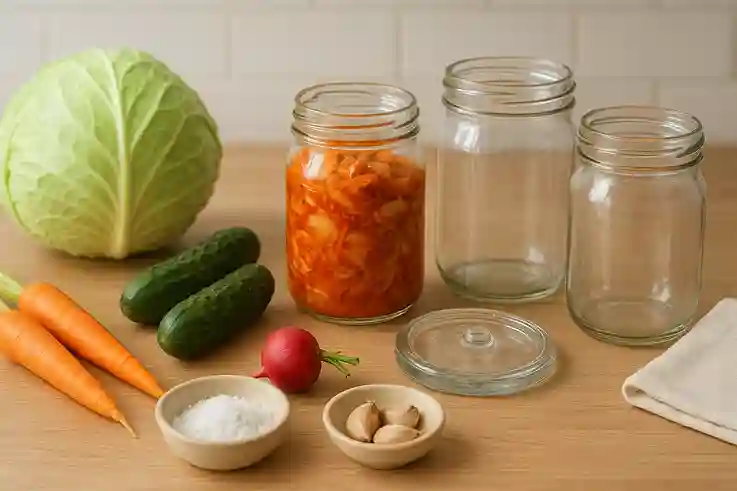
Common Vegetables
Cabbage, carrots, cucumbers, and radish are some of the best choices for homemade fermented vegetables. These vegetables remain firm during fermentation, providing a satisfying crunch in every bite. Their natural textures absorb flavors from salt, garlic, ginger, or spices, creating rich, tangy, and layered tastes. You can mix and match these vegetables to experiment with different textures and flavors in DIY sauerkraut or kimchi at home. Choosing fresh, firm produce ensures better fermentation results and a longer shelf life. Selecting the right vegetables is the first step toward successful and delicious easy fermentation.
Salt
Salt is a crucial ingredient in homemade fermented vegetables. It not only draws out moisture from the vegetables but also creates an environment that encourages beneficial bacteria to grow while preventing harmful microbes. Using the right type of salt—such as sea salt or kosher salt—ensures a clean, natural fermentation without additives or anti-caking agents.
The correct amount of salt balances flavor, enhances texture, and helps your DIY sauerkraut or kimchi at home stay crisp and safe to eat. Salt transforms simple vegetables into nutrient-rich, probiotic-packed foods through easy fermentation.
Optional Additions
Adding garlic, ginger, or spices can take your homemade fermented vegetables to the next level. These ingredients infuse DIY sauerkraut or kimchi at home with bold, layered flavors. Garlic adds a pungent kick, ginger brings a warm, zesty note, and spices like chili flakes, caraway seeds, or mustard seeds create complexity and aroma.
Beyond taste, some additions, like garlic and ginger, have natural antimicrobial and health-promoting properties, complementing the probiotics in fermented vegetables. Experimenting with different combinations allows you to customize flavors while keeping fermentation simple, fun, and packed with nutrition.
Tools
Using the right tools is key for successful homemade fermented vegetables. Clean glass jars are ideal because they are non-reactive and allow you to monitor the fermentation process. Fermentation weights help keep vegetables fully submerged in the brine, which prevents exposure to air and reduces the risk of mold. Covering the jars with a clean cloth lets gases escape while keeping dust, insects, and other contaminants out.
Simple tools like these make easy fermentation safe and reliable, whether you are preparing DIY sauerkraut or kimchi at home. Proper equipment ensures your fermented vegetables stay flavorful, crisp, and packed with probiotics.
Step-by-Step Fermentation Guide
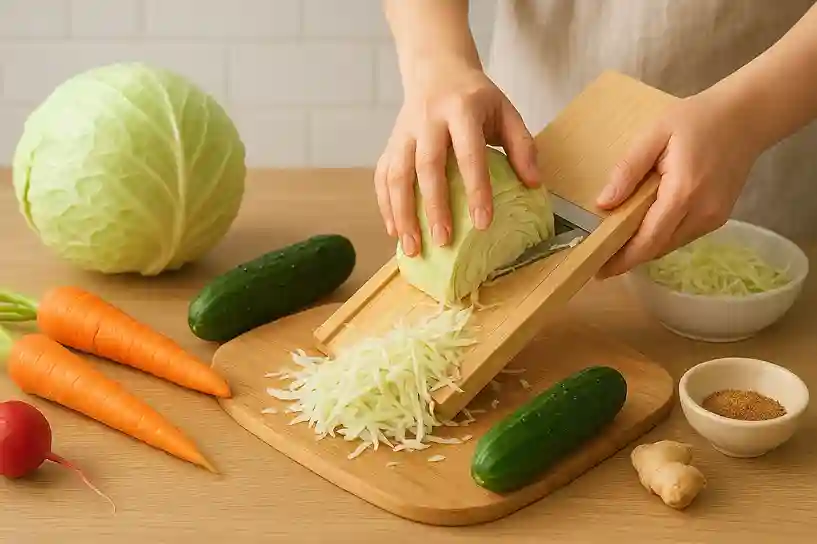
1. Prepare Vegetables
Washing, peeling, and chopping or shredding vegetables is the first crucial step in making homemade fermented vegetables. Clean, fresh cabbage, carrots, cucumbers, or radish provide the best texture and flavor for easy fermentation. Removing outer leaves and any blemishes reduces the risk of unwanted bacteria and ensures a safe fermentation process. Shredding or slicing vegetables evenly helps the brine penetrate thoroughly, producing consistent taste and crunch throughout the batch. Properly prepared vegetables also absorb flavors from garlic, ginger, or spices more effectively, making your DIY sauerkraut or kimchi at home delicious and probiotic-rich.
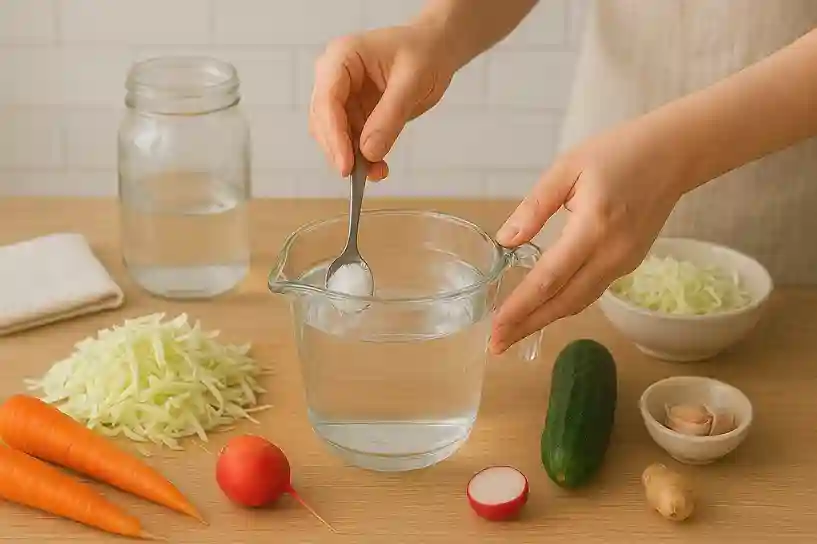
2. Make Brine
Making the brine is a key step in easy fermentation for homemade fermented vegetables. Mix clean water with salt—typically about 2 tablespoons per quart of water—to create a protective solution. The salt draws out moisture from the vegetables and creates an environment where beneficial bacteria can thrive while harmful microbes are suppressed. Using the right salt, such as sea salt or kosher salt, ensures no additives interfere with fermentation. Pour the brine over your chopped or shredded vegetables until fully submerged. This simple step sets the stage for DIY sauerkraut or kimchi at home that is both safe and rich in probiotics.
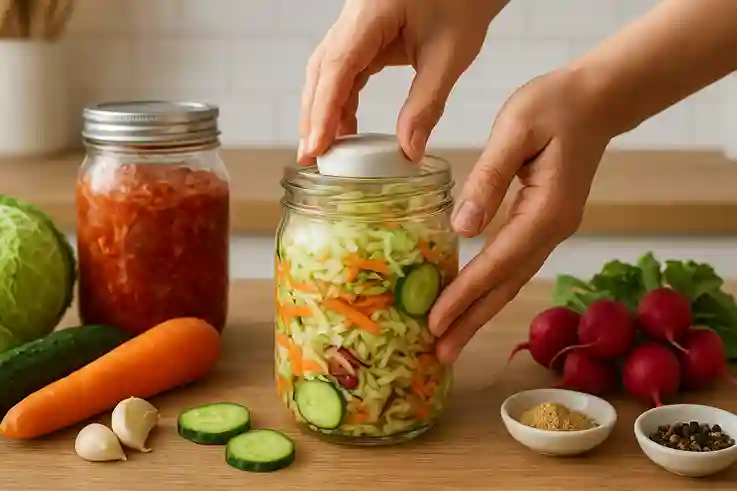
3. Pack the Jar
Packing the vegetables correctly is essential for successful homemade fermented vegetables. Press the chopped or shredded cabbage, carrots, cucumbers, or radish firmly into a clean glass jar. Use a fermentation weight or a small clean object to keep the vegetables completely submerged under the brine. Submersion is critical because exposure to air can lead to mold or spoilage. Ensuring the vegetables are fully covered also promotes the growth of probiotics, making your DIY sauerkraut or kimchi at home safe, flavorful, and rich in beneficial bacteria. Proper packing sets the foundation for a smooth, easy fermentation process.
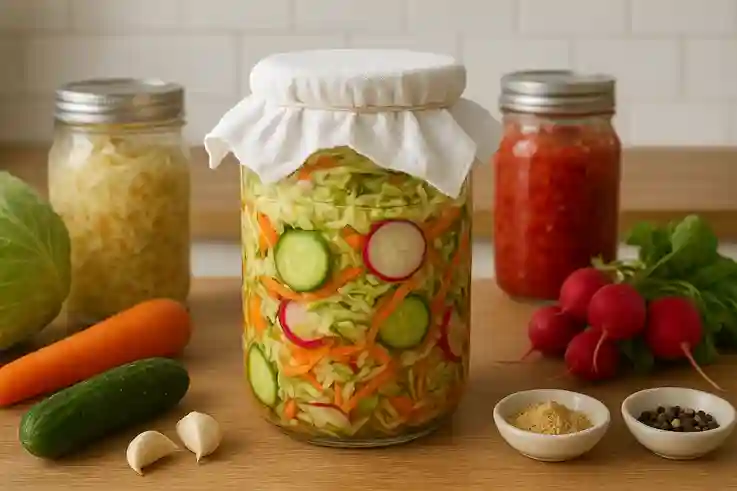
4. Ferment
Covering the jar properly is key to successful homemade fermented vegetables. Use a clean cloth or a breathable lid to allow gases produced during fermentation to escape while keeping dust, insects, and other contaminants out. Leave the jar at room temperature, ideally between 65°F and 75°F, for 3–7 days. The exact duration depends on your taste preference and the ambient temperature—warmer rooms speed up fermentation, while cooler rooms slow it down. During this time, beneficial bacteria convert sugars into acids, creating the tangy flavors of DIY sauerkraut or kimchi at home and enriching your vegetables with probiotics.

5. Check and Taste
During fermentation, it’s important to monitor your homemade fermented vegetables carefully. Look for small bubbles rising through the brine and a slightly sour, tangy aroma—both signs that probiotics are actively working. Taste the vegetables every day or two to track flavor development. DIY sauerkraut or kimchi at home is ready when it reaches your preferred level of tanginess and texture. Remember, fermentation continues even after refrigeration, so flavors will deepen over time. Regular tasting ensures you enjoy perfectly balanced fermented vegetables that are safe, flavorful, and rich in gut-boosting probiotics.
6. Store
Once your homemade fermented vegetables reach the flavor and tanginess you prefer, it’s time to seal the jar tightly and transfer it to the refrigerator. Cooler temperatures slow down fermentation, helping the vegetables retain their crisp texture and tangy taste for weeks or even months. Even in the fridge, the probiotics remain active, gradually enhancing the gut-friendly benefits of your DIY sauerkraut or kimchi at home. Proper storage ensures safety, flavor, and nutrition, allowing you to enjoy easy fermentation results anytime. A well-stored jar of fermented vegetables becomes a long-lasting, healthy staple in your kitchen.
Health Benefits of Fermented Vegetables
Rich in Probiotics
Fermented vegetables are naturally rich in live probiotics, the friendly bacteria that play a key role in maintaining gut health. These microorganisms help balance the gut microbiome, supporting smooth digestion and overall wellness. Making DIY sauerkraut or kimchi at home ensures that these probiotics remain active and abundant, unlike many store-bought versions that may be pasteurized.
Regular consumption of homemade fermented vegetables introduces a variety of beneficial bacteria, strengthening your digestive system and improving your body’s ability to process nutrients efficiently. Incorporating these probiotic-rich foods into your daily diet is an easy way to nurture long-term gut health.
Supports Digestion
Probiotics in fermented vegetables help break down food more efficiently, improving digestion and nutrient absorption. Regular consumption can reduce bloating, gas, and other digestive discomforts, making your digestive system feel lighter and more balanced. A well-functioning gut also supports metabolism, which can aid in healthy weight management.
Including homemade fermented vegetables, such as DIY sauerkraut or kimchi at home, in your daily meals encourages satiety, reduces cravings, and promotes a natural, gradual approach to weight loss while supporting overall gastrointestinal wellness.
Boosts Immune System
A healthy gut plays a crucial role in maintaining a strong immune system. Homemade fermented vegetables provide beneficial bacteria that support the growth of a balanced gut microbiome. These probiotics help the body defend against harmful microbes, reducing the risk of infections and illnesses. Regularly eating DIY sauerkraut or kimchi at home strengthens your body’s natural defenses while promoting overall wellness. By enhancing gut health, fermented vegetables create a foundation for long-term immune resilience, making them a simple yet powerful addition to your daily diet.
Enhances Nutrient Absorption
Fermentation enhances the nutritional value of vegetables by increasing the bioavailability of vitamins and minerals. This means your body can absorb nutrients more efficiently than from raw or cooked vegetables alone. Homemade fermented vegetables, like DIY sauerkraut or kimchi at home, retain essential nutrients while adding probiotics, making them both delicious and highly nutritious.
Regular consumption supports overall health, providing vitamins such as C, K, and B-complex, along with minerals like calcium and magnesium. Easy fermentation turns simple vegetables into a powerhouse of flavor and nutrition, helping you maximize the benefits of every bite.
Benefits of Fermented Food
| Fermented Food | Key Benefits |
|---|---|
| Sauerkraut | Rich in probiotics, supports digestion, boosts immunity, enhances nutrient absorption, may aid weight management. |
| Kimchi | Provides probiotics, improves gut health, supports immune system, anti-inflammatory, enhances vitamin absorption. |
| Pickles (fermented) | Supplies beneficial bacteria, aids digestion, preserves nutrients, supports immunity. |
| Kefir (vegetable-based) | Probiotics for gut balance, improves digestion, boosts immune function, rich in calcium and protein. |
| Miso | Fermented soybean paste; supports probiotics, digestion, and nutrient absorption; contains antioxidants. |
| Tempeh | Fermented soy; high in protein, supports gut health, improves digestion, enhances nutrient uptake. |
| Fermented Carrots | Rich in probiotics, supports digestion, adds vitamins A and C, strengthens immunity. |
| DIY Sauerkraut / Kimchi at Home | Fresh, probiotic-rich, customizable flavors, supports digestion and immunity, easy fermentation at home. |
This table highlights both taste and health benefits of fermented vegetables and other fermented foods, emphasizing homemade options, easy fermentation, DIY sauerkraut, and kimchi at home.
USDA Agricultural Research Service (ARS) – The Health Benefits of Fermented Vegetables
Variations & Recipes
Classic Sauerkraut
Classic sauerkraut starts with shredded cabbage and a bit of salt. The salt draws out moisture, creating a natural brine that encourages probiotic growth. Leave the cabbage at room temperature for several days to ferment, allowing beneficial bacteria to develop tangy flavors and a satisfying crunch. Making DIY sauerkraut at home ensures freshness and preserves nutrients while keeping it free from preservatives. You can customize the taste by adding garlic, caraway seeds, or other spices, creating a flavor profile that suits your palate. This simple, probiotic-rich homemade fermented vegetable is perfect as a side dish or snack.
Spicy Kimchi
Spicy kimchi begins with napa cabbage, radish, and chili flakes, creating a bold and tangy base. Adding ginger, garlic, and a touch of fish sauce enhances depth and complexity of flavor. Through easy fermentation, these ingredients transform into probiotic-rich kimchi at home, packed with beneficial bacteria that support gut health. Regularly enjoying homemade fermented vegetables like kimchi introduces probiotics naturally while preserving essential vitamins and minerals. You can adjust the spice level or experiment with additional vegetables to customize the taste, making DIY kimchi at home a fun and nutritious addition to any meal.
Quick Refrigerator Pickles
Quick refrigerator pickles are a fast and easy way to enjoy homemade fermented vegetables. Thinly sliced cucumbers or carrots are lightly salted and combined with spices such as dill, garlic, or chili flakes. Placing the jar in the fridge slows fermentation while still allowing beneficial bacteria to develop, producing tangy, crisp, and flavorful pickles in just a few days.
This method is ideal for beginners who want easy fermentation without long wait times. Quick refrigerator pickles retain nutrients, probiotics, and natural flavors, making them a convenient and healthy addition to meals or snacks.
Overview of Ingredients, Fermentation Time, and Key Notes
| Fermented Vegetable / Recipe | Key Ingredients | Fermentation Time | Notes |
|---|---|---|---|
| Classic Sauerkraut | Cabbage, salt, optional garlic or caraway seeds | 3–7 days at room temperature | Tangy, crunchy, rich in probiotics |
| Spicy Kimchi | Napa cabbage, radish, chili flakes, ginger, garlic, fish sauce | 3–7 days at room temperature | Adjust spice and salt to taste |
| Quick Refrigerator Pickles | Cucumbers or carrots, salt, spices (dill, garlic, chili) | 2–5 days in fridge | Fast fermentation, crisp texture |
| Fermented Carrots | Carrots, salt, optional ginger or garlic | 3–7 days at room temperature | Sweet and crunchy, probiotic-rich |
| DIY Sauerkraut / Kimchi at Home | Mix of cabbage, radish, carrots, salt, optional spices | 3–7 days at room temperature | Customizable flavors, easy fermentation |
This table gives a clear overview of ingredients, fermentation time, and key notes, making it easier for readers to plan their DIY fermented vegetables projects.
Frequently Asked Questions (FAQ)
Conclusion
Making fermented vegetables at home is simpler than most people think. With just fresh vegetables, salt, and a few basic tools, you can create DIY sauerkraut, kimchi at home, or quick refrigerator pickles that are rich in probiotics and flavor. Regularly including homemade fermented vegetables in your diet supports digestion, strengthens immunity, enhances nutrient absorption, and may even aid in healthy weight management. Easy fermentation allows you to experiment with flavors while enjoying the full benefits of these nutritious foods.
Try your first jar today and share your experience in the comments!

Alexia Greene is a health blogger dedicated to making wellness simple, practical, and accessible for everyone. With a strong background in nutrition and healthy living, she writes about balanced diets, fitness tips, and mindful habits that support long-term well-being. Alexia’s mission is to empower readers with trustworthy information and actionable steps they can use in their everyday lives.
When she’s not writing, Alexia enjoys cooking wholesome meals, practicing yoga, and exploring new ways to live a healthier lifestyle. Her approachable style and evidence-based advice make her a trusted voice in the world of health and wellness blogging.
